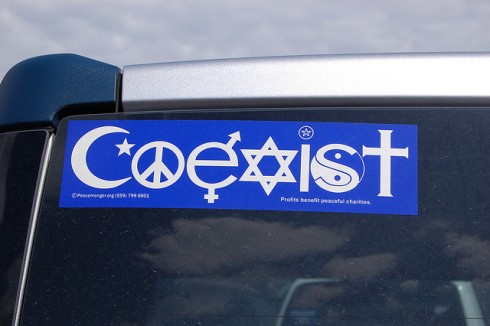 e’ve hit a glass ceiling.
e’ve hit a glass ceiling.
We’re stalled on the interstate without a map. And the map has yet to be drawn.
We’re told that each institutionalized religion is the only path to salvation, righteousness, prosperity, truth, wisdom, peace, etc. ad nauseum.
But when we start to personally unfold into new stages of growth (within and without), when we start to become a more mature version of ourselves, we sometimes find that our religion doesn’t provide a mature form of spirituality. It’s like having an appliance crap out on you the day after your 5-year warranty expires.
ERROR: We apologize, we are no longer offering support (technical, emotional, or spiritual) for versions 5.X (and above) of the “Your Self” hardware. If you’d like to be notified when this support becomes available, join the club.
Religion itself suffers from a form of philosophical retardation, permanently stunted at a level of adolescence, unable to position itself in relationship to others – unable to take second- and third-person perspectives.
According to Bishop John Shelby Spong, “the church doesn’t like for people to grow up, because you can’t control grown-ups.”
Here’s what Integral theorist, Ken Wilber has to say on the subject:
Everybody is born at square one. There will always be people at [all stages of consciousness] and that is fine. An enlightened society would always make room for that by recognizing that stages in development are also stations in life. And somebody can stop at any of those stations (of Spirit’s own unfolding) and they deserve honor and respect at whatever station they are at.
click image to enlarge
But the earlier stations — archaic to magic to mythic — involve stages that, nonetheless, are ones that humanity’s leading edge passed through in its infancy, childhood, and adolescence. But because religion alone is the repository of the myths created during those times, religion alone is the institution in today’s world that gives legitimacy to those earlier stages and stations for men and women. And religion alone owns that 70% of the world’s population at those stages.
All of which is good and beautiful. But precisely because of its ownership of the pre-rational heritage of humanity (and the pre-rational corpus of the great myths), religion alone can help its followers move from the pre-rational, mythic-membership, ethnocentric version of its message to the rational, worldcentric versions of its own message. … This, surely, is the great role for religion in the modern and postmodern world.
(excerpted from Integral Spirituality)
If “religion” continues to be defined as the tactile and social side of spirituality — rooted in dogma, doctrine and myth — and as long as those myths continue to be told (and interpreted) from magic and pre-rational levels of development, there will be no forms of religion at the higher stages (rational, collaborative or pluralistic).
All interfaith dialogue will hit a dead end, religious fundamentalism will remain the status quo, holy wars will continue to be waged, and we will continue to seek (to sometimes extreme ends) that which we already are and have always been.
UPDATE: Some of the Abrahamic traditions (Christianity, Judaism and Islam) do have maps of the higher stages provided by Christian Mysticism, Kabbalah and Sufism, respectively. But, they are for the most part denied or attacked by the institutional and patriarchal forms of these religions.
Yes, new myths need to be written from these higher stages of unfolding. New stories need to be told from a level of consciousness that includes the highest number of perspectives. But more importantly, current mythology and doctrine needs to be interpreted, understood and possibly re-cast from these higher stages. That is what will shatter the glass ceiling.
It’s time to change this system from within. And here’s what you can do about it:








